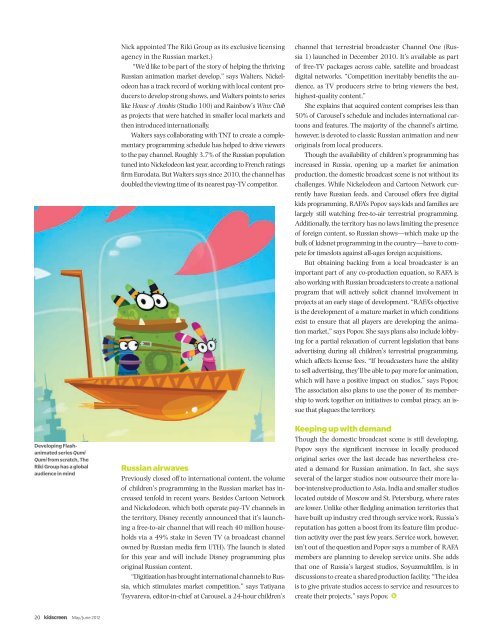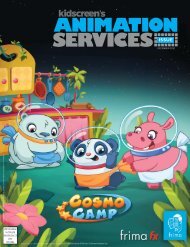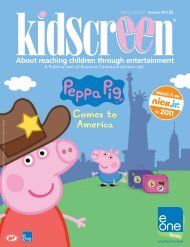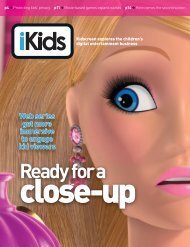download a PDF version - Kidscreen
download a PDF version - Kidscreen
download a PDF version - Kidscreen
You also want an ePaper? Increase the reach of your titles
YUMPU automatically turns print PDFs into web optimized ePapers that Google loves.
Developing Flashanimated<br />
series Qumi<br />
Qumi from scratch, The<br />
Riki Group has a global<br />
audience in mind<br />
20 May/June 2012<br />
Nick appointed The Riki Group as its exclusive licensing<br />
agency in the Russian market.)<br />
“We’d like to be part of the story of helping the thriving<br />
Russian animation market develop,” says Walters. Nickelodeon<br />
has a track record of working with local content producers<br />
to develop strong shows, and Walters points to series<br />
like House of Anubis (Studio 100) and Rainbow’s Winx Club<br />
as projects that were hatched in smaller local markets and<br />
then introduced internationally.<br />
Walters says collaborating with TNT to create a complementary<br />
programming schedule has helped to drive viewers<br />
to the pay channel. Roughly 3.7% of the Russian population<br />
tuned into Nickelodeon last year, according to French ratings<br />
fi rm Eurodata. But Walters says since 2010, the channel has<br />
doubled the viewing time of its nearest pay-TV competitor.<br />
Russian airwaves<br />
Previously closed off to international content, the volume<br />
of children’s programming in the Russian market has increased<br />
tenfold in recent years. Besides Cartoon Network<br />
and Nickelodeon, which both operate pay-TV channels in<br />
the territory, Disney recently announced that it’s launching<br />
a free-to-air channel that will reach 40 million households<br />
via a 49% stake in Seven TV (a broadcast channel<br />
owned by Russian media fi rm UTH). The launch is slated<br />
for this year and will include Disney programming plus<br />
original Russian content.<br />
“Digitization has brought international channels to Russia,<br />
which stimulates market competition,” says Tatiyana<br />
Tsyvareva, editor-in-chief at Carousel, a 24-hour children’s<br />
channel that terrestrial broadcaster Channel One (Russia<br />
1) launched in December 2010. It’s available as part<br />
of free-TV packages across cable, satellite and broadcast<br />
digital networks. “Competition inevitably benefi ts the audience,<br />
as TV producers strive to bring viewers the best,<br />
highest-quality content.”<br />
She explains that acquired content comprises less than<br />
50% of Carousel’s schedule and includes international cartoons<br />
and features. The majority of the channel’s airtime,<br />
however, is devoted to classic Russian animation and new<br />
originals from local producers.<br />
Though the availability of children’s programming has<br />
increased in Russia, opening up a market for animation<br />
production, the domestic broadcast scene is not without its<br />
challenges. While Nickelodeon and Cartoon Network currently<br />
have Russian feeds, and Carousel off ers free digital<br />
kids programming, RAFA’s Popov says kids and families are<br />
largely still watching free-to-air terrestrial programming.<br />
Additionally, the territory has no laws limiting the presence<br />
of foreign content, so Russian shows—which make up the<br />
bulk of kidsnet programming in the country—have to compete<br />
for timeslots against all-ages foreign acquisitions.<br />
But obtaining backing from a local broadcaster is an<br />
important part of any co-production equation, so RAFA is<br />
also working with Russian broadcasters to create a national<br />
program that will actively solicit channel involvement in<br />
projects at an early stage of development. “RAFA’s objective<br />
is the development of a mature market in which conditions<br />
exist to ensure that all players are developing the animation<br />
market,” says Popov. She says plans also include lobbying<br />
for a partial relaxation of current legislation that bans<br />
advertising during all children’s terrestrial programming,<br />
which aff ects license fees. “If broadcasters have the ability<br />
to sell advertising, they’ll be able to pay more for animation,<br />
which will have a positive impact on studios,” says Popov.<br />
The association also plans to use the power of its membership<br />
to work together on initiatives to combat piracy, an issue<br />
that plagues the territory.<br />
Keeping up with demand<br />
Though the domestic broadcast scene is still developing,<br />
Popov says the signifi cant increase in locally produced<br />
original series over the last decade has nevertheless created<br />
a demand for Russian animation. In fact, she says<br />
several of the larger studios now outsource their more labor-intensive<br />
production to Asia, India and smaller studios<br />
located outside of Moscow and St. Petersburg, where rates<br />
are lower. Unlike other fl edgling animation territories that<br />
have built up industry cred through service work, Russia’s<br />
reputation has gotten a boost from its feature fi lm production<br />
activity over the past few years. Service work, however,<br />
isn’t out of the question and Popov says a number of RAFA<br />
members are planning to develop service units. She adds<br />
that one of Russia’s largest studios, Soyuzmultfi lm, is in<br />
discussions to create a shared production facility. “The idea<br />
is to give private studios access to service and resources to<br />
create their projects,” says Popov.
















